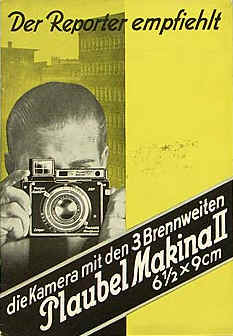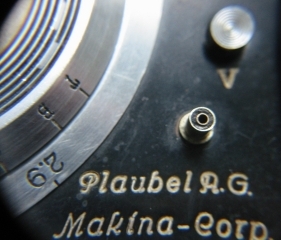



The PLAUBEL Makina II Black finish
interchangeable lenses available
Press Camera
1930-1939
by Jo Lommen
"The press man recommends the Plaubel Makina II 6 1/2 x 9 cm the camera with 3 focal length " "Plaubel Makina II - Plaubel Salesdepartment Braunschweig"
The Plaubel & Co., Frankfurt/Main -Germany, founded in 1902 by Hugo Schrader, son-in-law from Dr. Kruegener, produced the Plaubel Makina II starting in 1933 up to 1939 with coupled range-finder and an Anticomar 2,9 / 100 mm High Speed lens.
The Makina I was its predecessor and lacked the coupled rangefinder. Type1was produced in the early twenties with an Anticomar 4,2/100 mm. The direct vision optical Newton view finder was placed in the middle of the camera and equiped wit a dial in stead of a rim. On type II the direct vision optical viewfinder moved to the edge of the camera . Other improvements were: A supply to let the air out of the bellows while closing it, a blue eyepiece mounted in a square level and as from 1927 a strap holder.
Producing strut folding camera’s came to an end in the fifties of the last century, but Plaubel continued the production and improved the Makina up to the sixties with the Makina III. Starting with the Makina I and followed by its successors, the Makinas were very popular with the press. Not only because its small and handsome design, but especially its reliability and very fast Anticomar 2,9 lens. The solid camera-body not only receives 6x9 cm sheet-film holders, but also the special Plaubel 6x9 roll-film holder. The adjustment to the camera of these devices is extremely reliable.
As you can see on the pictures, the Makina II has a rim with aperture and shutter time adjustment, a solid range-finder on top, a direct vision optical viewfinder, a high speed lens, a compact design for that time and a very reliable construction. But apart from this, the most attractiveness is its design! It reminds me of the roaring twenties. Whether the front plate is black or chrome, its a beauty !
This is a beautiful, quality
made, Plaubel Makina ii Rangefinder medium format camera with a 10cm (100mm)
f2.9 Anticomar lens system. This made in Germany camera has a great black finish
with nickel metal accents offering a rangefinder, “sports finder” with parallax
correction and a ground glass. This camera takes 2-1/4 x 3-1/4” images on 120 film with its included roll film back and also
shoots to sheet film with its included holder too.


The Anticomar 1:2,9 / 10 cm is an ideal lens set in a Compur shutter for spontaneous work especially for pictorial work in landscape and portrait photography. Where a graduation of subtle grey tones, a soft definition and a certain plasticity is required, this lens is unsurpassed. A super compact camera with a nice geared focusing design
The Makina II is fitted with a Compur shutter with shutter times from 1/1 to 1/200 , "T" and "B" and a non changeable Plaubel Aniticomar 2,8. F=10 cm. lens.
"V" (German=Vorlauf) = self-timer. To use this, press the "V" button and cock the "S" (Spannen) shutter-level at the same time. You'll find the diaphragm aperture control on the right side of the camera front, marked "R"
"Please note that the self-timer cannot be used without damage to the shutter when the shutter has been set to 1/200, T or B.
The shutter cannot be cocked when the shutter-time is set to T or B"
Both, shutter speed and aperture control are placed around the lens.

The beautifully designed Plaubel Makina II Press Camera


The camera has a very solid strut folding construction, easy to handle and if collapsed, it will easily finds a place in the pocket of a raincoat.
To open the camera, just lift the focusing knob upwards and the front of the camera comes out of the housing. The strut folder mechanism locks automatically if it arrives in infinity position. To close the camera squeeze both knobs on top and on the bottom of the front plate to unlock the strut folding mechanism and press the camera front gently back into the housing until it clicks.
The Plaubel Makina II is equiped with a direct vision Newton Viewfinder, a sports finder with a hinged open frame-finder and a focusing ground-glass with hood. If you focus by using the range-finder, you can check the adjustment by reading the figures on the front (in meters) .
Note: The rangefinder is only coupled to the Anticomars 1: 2,9 / 10 cm and the 4,2 / 10 cm
The
Anticomar 1:2.9/10 cm. is an ideal lens for spontaneous work, especially for
pictorial work in landscape and portrait photography.
Where a graduation of subtle grey tones, a soft definition and a certain "plasticity" is required
this lens is unsurpassed.
To couple the Tele-Makinar 1:6,3 - 21 cm- , take the regular Anticomar
front and rear lens out of the camera and set the diaphragm at 2,9 - the largest
opening.
USING LENSES
Tele Makinar
for use at large distance:
1) preparation: remove front and rear lens from the camera
and set diaphragm open on 2.9
2) set Tele Makinar at infinity
3) use focus knob to set ground glass till far away subject is in focus.
4) make notes or mark distance scale
5) Set exposure speed on camera and diafragm on Tele Makinar.
Setting aperture diaphragm
always use the Tele Makina lens setting rather than the camera diaphragm setting
rim.
For Portrait photography
1,5 meter 5 feet
preparation: remove front
and rear lens from the camera and set diaphragm open on 2.9
Set both camera and Tele Makinar on infinity.
Mount conversion lens T 1,5 on Tele Makinar.
Set exposure time
No further setting necessary. Camera has been set now to focus on 1,5 meter.

The Tele-Makinar
1:4.8, f:19 cm. (71/,4i n.)
Front and rear lens of the Anticomar
should be removed
before installing the Tele Makinar
Before
installing the Tele Makinar, unscrew the rear-lens inside the camera house by
sliding the ground glass assembly out of the camera back.
Now fold the front
part of the camera back. The rear-lens is now pretty easy reachable to screw it
out of the camera.
To mark the different image areas covered by the Tele-lens, the front optical
viewfinder shows the frame engraving. The changing and the removal of the Tele-Makinar
S does not differ from that of the Anticomar. On some Makina cameras you will
find a red triangle, and another red mark is on the diaphragm ring of the Tele-Makinar.
In order to enable the photographer to read the stop-numbers from above it is
recommended that the two red markings on ring and front-panel should coincide
when the Tele-Makinar is inserted. However, should it be screwed in differently,
no harm will be done. The Tele Makinar as well as the Anticomar have their own
iris-diaphragm that can be set in the usual way. On top of the lens barrel, stop
numbers are engraved, and above them are placed the distances in metres or feet.
These two scales together form a convenient depth-of-field-ring giving the
correct depth of field for every aperture. The Tele-Makinar S employs the same
catch spring as the Anticomar. It is semi-automatically coupled to the
range-finder, which means that
the distance is measured with the range-finder and then read off
from the Anticomar-scale.
The focusing device of the camera remains unaltered, but the distance measured
is set on the Tele-Makinor, which has its own distance setting in its helical
mount. For instance: The subject is 9 feet away from the camera. Measuring with
the range-finder results in the Anticomar scale showing a distance of 9 feet.
Now the Tele Makinar l.:4.8/19 cm by virtue of its helical mount is also set to
9 feet, without altering the distance setting of the camera.



To hold the camera in the right position to shoot, you have to practice. Forget the strap! You’ll better take fast the camera on the back with your left hand, holding your fingers in the inside of the camera-back, and the front with your right hand, so that your finger can touch the shutter release knob "A"=Auslöser). Then move with your left hand to the distance adjusting knob to focus. In the mean time you have to hold the camera with your right hand on the front plate, having almost no grip. I think they never heard of ergonomic at that time. The successor, Makina III, came with a handle on the front, which was just a poor improvement.

Pressing the knob "V" and cocking the shutter at the same time
loads the self timer, a mechanic device that gives a delay between pressing the
release knob and firing the shutter.
The German name for self timer is "Vorlauf"

The flash synch on the Makina II is for bulbs only, since it makes contact milliseconds before the shutter opens, to wait for the peak of the flash. So it makes no sense to connect an electronic flash. The photo will be dark, because the flash will go off before the shutter has been totally opened. Three focusing features are standard on the Plaubel. The sportsfinder with hinged frame on the front and sight for frame finder on the back. Eye piece for the coupled rangefinder in the middle and a blue lens for focusing with the Newton optical viewfinder in front.

Rangefinder
The rangefinder of
the Plaubel Makina is based upon the, coincidence principle i.e. it contains 2
mirrors, one rigid and one adjustable the latter of which is moved by the
focusing device of the camera, When looking through the eye-piece of the range
finder you will see a rectangular image of yellowish colour and a small round
picture of white- colour. By turning the focusing screw (on left front side of
the camera front, the strut folding mechanism of the camera adjust simultaneously the
front plate and the moveable mirror in such a way that the circular white picture moves
over the yellowish one. When both pictures coincide the picture is correctly
focussed and absolutely sharp.
Sometimes the adjustment is incorrect and the rangefinder must be readjusted.
How to
readjust the rangefinder
follow this link to learn how
Important tip
when using film holders.
Although the Makina is fitted with efficient air ducts, suction of the bellows is unavoidable and could make the film curve when the dark slide is open. First open the camera and next draw the dark slide. This measure is superfluous if the f stop is set on 6 or higher. Smaller apertures for increasing the depth of field will overrule the curve of the film.
Focal Plane Accessory
Unlike the Makina II which was equiped with a fixed lens, the successors Makina II S and the Makina III became interchangeable lenses with all lens elements in front of the shutter. There was also a focal plane shutter available to mount on the back of the camera. (100-200-300-600-1000 sec). The detachable Focal Plane Shutter unit is slit into the rails on the camera back. Owing to the thickness of the shutter the extension of the bellows has to be altered to restore the distance between lens and film plane.
The Makina II S and Makina III
Chrome finish
plus interchangeable lenses.

The Plaubel Makina II S camera with chrome front plate.
Both cameras the Makina II as well as the Makina II S and even the Makina III
can be equiped with the Makina Roll Film back.
How to use the Plaubel Roll Film Back.
Home Jo Lommen Camera European Press Cameras